Getting your music on Spotify editorial playlists is the fastest way to explode your Spotify streams and followers, and it can revolutionize your music career overnight.
But how exactly do you get your music on a Spotify editorial playlist?
The key to getting your music added to Editorial Playlists is to…
Release music consistently and build up your streams so that the Spotify editorial team takes notice and adds your music to their editorial playlists. In order to grow your streams and get noticed, focus first on getting your music added to user-generated and algorithmic Spotify playlists.
Simple, huh?
Okay, I know, that's easier said than done, but in the rest of this article, I'll walk you through not only how to submit your song to the Spotify editorial team for consideration…
But how to write the best pitch possible, and also how to get your music on user-generated and algorithmic playlists, which you have much more control over.
If all this playlist types talk is confusing you, here's a quick break down of the three different playlists on Spotify:
What Are The Different Types Of Playlists On Spotify?
On Spotify, there are three different types of playlists, and they are easily broken down as follows:
- User-Generated Playlists: Public playlists created by regular users of Spotify like you
- Algorithmic Playlists: Playlists that are generated automatically by the Spotify algorithm
- Spotify Editorial Playlists: Playlists that are curated and maintained by actual humans who work at Spotify
We can't directly control whether or not we get on any of these playlists, except for user-generated playlists.
We can grow our own, and we can reach out to other people who are curating playlists on Spotify.
By getting your music on user-generated playlists, you can help your music to also get added to algorithmic playlists, which can then get your music on editorial playlists (more on this below).
Get Your Songs On Spotify Playlists
Click below to download my free guide covering a simple formula you can follow to get your songs on Spotify playlists and explode your streams without spending a dime!
How To Submit A Song To Spotify Editorial Playlists
You can submit one new song to the Spotify editorial team if it is at least 7 days before it's release date.
However, it's best to submit your song 4 weeks in advance to give Spotify the most time possible to review your song.
In order to find your song to submit, you simply login to your Spotify for Artists account, click on “music” in the top menu, and then “upcoming”.
Music > Upcoming.
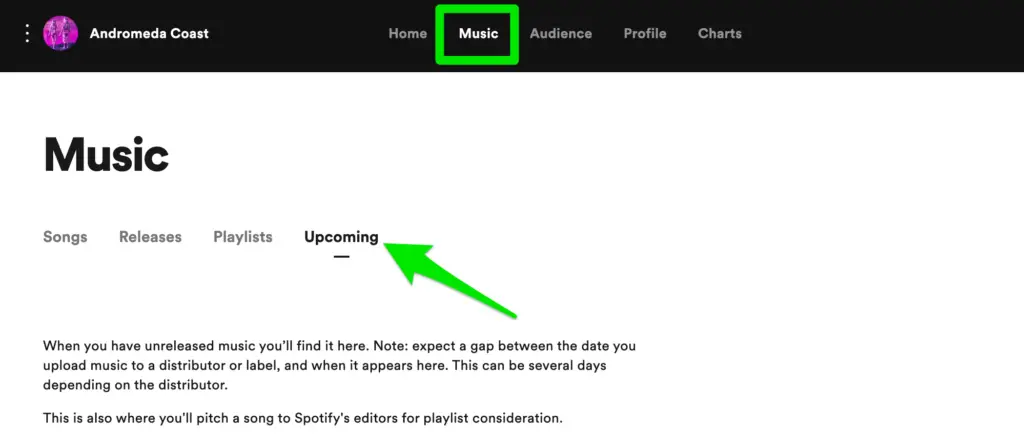
How Often Can You Submit To Spotify Editorial Playlists?
You can submit your music to the Spotify editorial team as often as a you like, but you can only submit one song at a time. This means once you have submitted one song, you cannot submit another song until the previous one goes live. You also must submit at least 7 days before your release date.
Because of this model, it's a great idea to focus on releasing more singles, rather than saving all of your songs up for an album or EP.
This is because you get more “at bats” to get your music on an editorial playlist.
For example, if you release 12 songs this year, but they're part of an album, you can only submit one song off that album for consideration for an editorial playlist.
However, if you released all of those songs as singles, you now have 12 pitches and 12 shots to get your music added.
Obviously, a much better strategy.
Plus, you can always group your singles together into an album on Spotify after they have been released.
How To Actually Get Accepted To Spotify Editorial Playlists
Okay, now you know how to submit your music to the Spotify editorial team, but how do you do so in a way that actually gets your song accepted?
The reality is even if you write the perfect pitch, you're probably not going to get your music added because the editorial team receives so many submissions.
A little later in this article I'll share what you can do to get Spotify's attention before you submit, but first, it's important to understand how the Spotify algorithm works.
How The Spotify Algorithm Works
Before Spotify starts promoting your music for you, they want to know you have music worth promoting.
This means you need to give the algorithm and the editorial team some “positive indicators” that you have good music.
These positive indicators include things like your listening time, saves, playlist adds, streaming velocity, and so on.
Just like every other social media platform, Spotify's goal is to keep their users on their platform for as long as possible.
This is because the longer people are on their platform, the more ads they can display, and the more revenue they can generate.
Because of this motivation, Spotify's chief aim is to provide a great user experience, and…
If you can demonstrate that your music keeps people on their platform, then they will happily share it with more people.
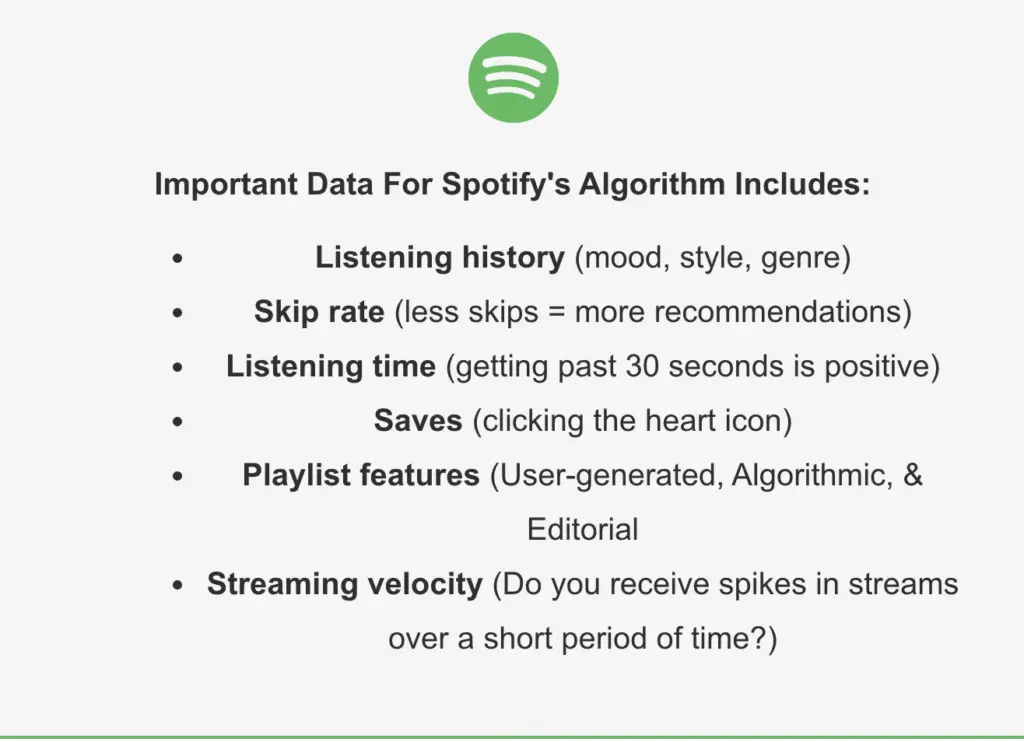
So if you want to get added to a Spotify editorial playlist, you first need to show Spotify that you're having some success and people are enjoying your music.
This means we first need to build up your streams and other positive indicators…
And here's how you do it…
1. Update Your Account BEFORE You Submit
If the editorial team ends up looking at your Spotify profile, you want them to see that you are a “good citizen” of their platform.
This means they want to see that you are active and updating your account regularly.
If they visit your account and see that everything is old and you don't seem very active, then they'll probably conclude you aren't serious about promoting your music and bringing new people to their platform.
So before you submit, be sure you:
- Update your pictures in your Spotify profile
- Update your bio in your Spotify profile
- Have recent posts to your connected social media accounts
- Have selected an “Artist's Pick”
- Have “Artists Playlists” listed and recently updated
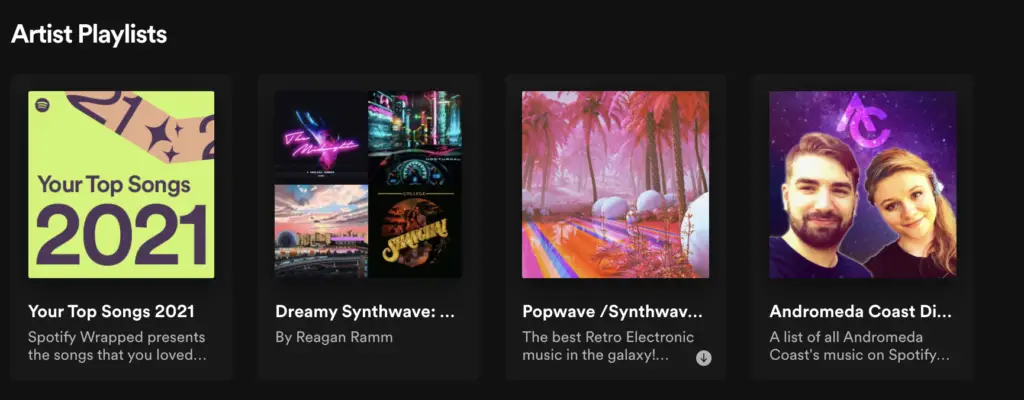
2. Release Music Consistently
The Spotify platform rewards consistency.
Spotify is basically trying to become a social media platform, and just like social media, you wouldn't go for more than a month without posting if you were serious about trying to grow your following, right?
The same goes for Spotify, and the best way to grow is to release at least one new single every 4-8 weeks.
Spotify's CEO himself said:
“You can’t record music once every three to four years and think that’s going to be enough…The artists today that are making it realize that it’s about creating a continuous engagement with their fans… It is about putting the work in, about the storytelling around the album, and about keeping a continuous dialogue with your fans.”
Spotify CEO Daniel Ek
Why Consistency Is The Key To Successful Spotify Editorial Playlist Submissions
By releasing something every month or two, and creating several pieces of content around each of these releases, such as a music video, lyric video, behind-the-scenes video, and so on, then every week you have something relevant to talk about concerning your music.
You don't have to just post the same, “Go listen to my music” message over and over. You'll actually have something new to talk about, which keeps fans engaged and helps them to go from being casual listeners to superfans who are actually willing to spend money with you.
DistroKid is a great music distributor for this strategy because they allow you upload unlimited songs and charge you by the year, and not by the upload, unlike other distributors.
Speaking of which, you can get 7% off your first year of DistroKid if you use my link here.

Get DistroKid 7% Off
Get started with DistroKid and get access to all of their great tools for distributing and promoting your music.
Isn't Uploading Consistently Too Much Work To Maintain?
Not at all!
In fact, if you're releasing singles, then you only need to publish 6-12 songs a year to maintain momentum and grow your Spotify streams and followers.
If you need more help creating music consistently, then check out some of my articles here:
- 10 Tips For Slaying Discouragement When Writing A Song
- How To Write A Song In 1 Hour (Become A Songwriting Machine)
- 5 Simple Steps For Easily Writing Lyrics
3. Promote Your Music Consistently
You also need to be promoting your music consistently.
Just creating good music isn't enough because if no one knows about you, it doesn't matter how good your music is.
So every time you release your music, you want to have a marketing plan built up around your song.
You want to know how you will promote it both before and after release.
This involves planning out what images you'll post on social media, what videos you'll create to promote your song, what emails you'll send out to your mailing list, and more.
For even more help…
Check out my complete guide on how to grow your Spotify streams here.
This covers 22 different tips that you can implement to grow your Spotify streams and followers so you can get noticed by the Spotify editorial team.
4. Get Your Music Added To Algorithmic Playlists
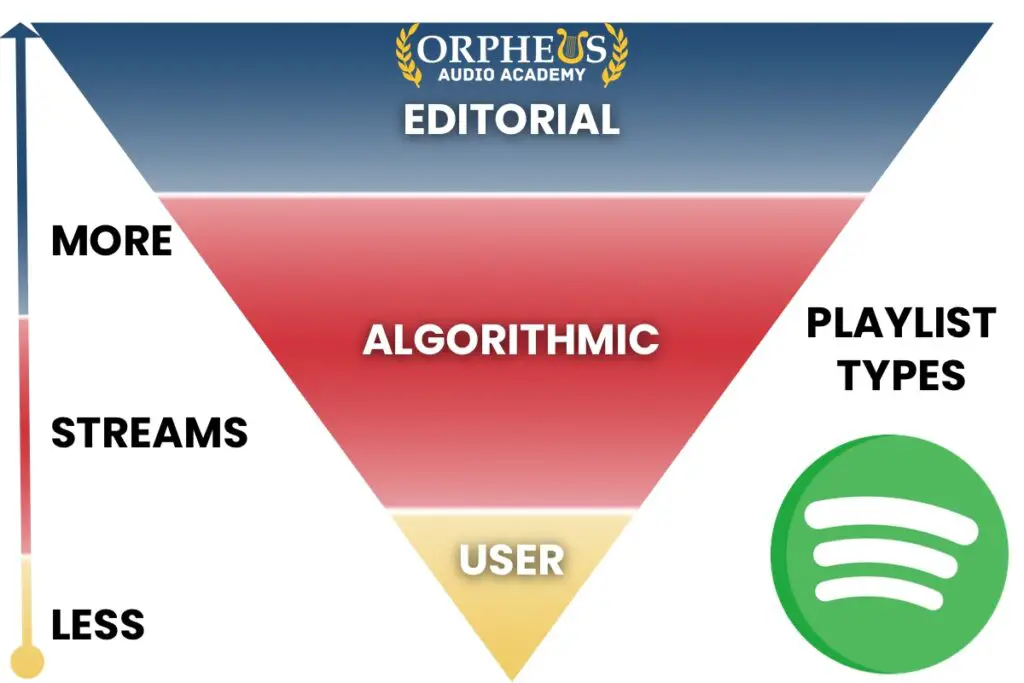
Getting your music on algorithmic playlists is the fastest way to get the attention of the Spotify editorial team.
Spotify algorithmic playlists include:
- Discover Weekly
- Release Radar
- Daily Mix
- Spotify Radio
- On Repeat and Repeat Rewind
How To Get On Algorithmic Playlists
However, just like editorial playlists, we can't directly control whether our music gets added to algorithmic playlists.
This is because these playlists are built automatically by the Spotify algorithm. So to get added to these playlists, we first need to grow our streams and followers on our own…
And the best way to do this is to get our music on user-generated playlists.
User-generated playlists are the easiest to get your music on, and we actually have more control over getting placed on these playlists.
I've put together a full guide for you on how to do this that you can download here.
Get Your Songs On Spotify Playlists
Click below to download my free guide covering a simple formula you can follow to get your songs on Spotify playlists and explode your streams without spending a dime!
By getting your music on user-generated playlists, you can trigger the Spotify algorithm and actually start to get your music placed in algorithmic playlists.
From there, as you continue to consistently release, promote, and grow your streams and followers, you'll catch the attention of the Spotify editorial team and get added to Spotify editorial playlists.
As you can see, Spotify growth comes down to the “snowball effect.”
You can put a lot of work in the beginning and see very little results. This can cause many indie artists to give up because they assume it will literally take them centuries to generate any really traction and income from Spotify.
However, Spotify growth, done right, isn't linear, but exponential.
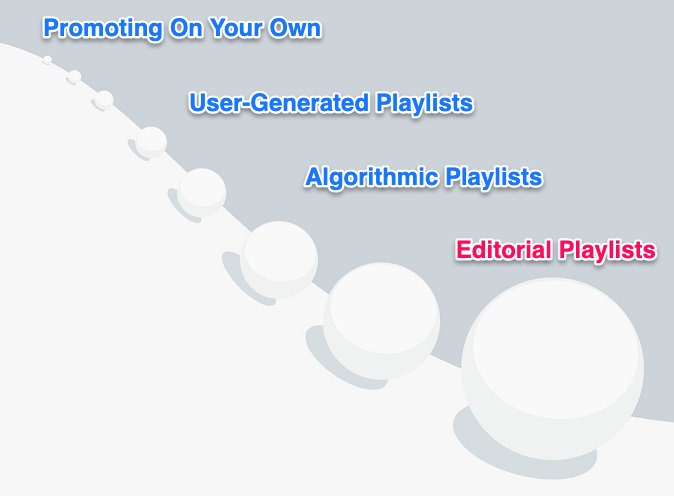
5. Write A Great Pitch
Finally, we arrive at actually writing a great pitch when submitting your song to the Spotify editorial team.
You can check out my video below which walks you through how to submit your song to the editorial team, but keep reading to learn what you want to include in your pitch.
Say What Makes You Unique & Exciting
As with any pitch, whether you're applying for a job or trying to get your music added to an editorial playlists, it's important to remember this is about THEM, and not you.
Spotify wants to know how they will benefit by adding your music to their editorial playlists.
With this in mind, you'll want to point out what makes you unique, exciting, and how you'll be working to promote your song yourself.
In other words, what can you say about yourself that will help you stand out above the noise of all the other thousands of submissions Spotify receives every day?
Use Quotes From Prominent People Or Media You've Been Featured In
If you have any social proof, such as a quote about your music from someone prominent, or you've been featured in a music magazine or website, mention this as well.
If you don't have anything this to list, that's totally fine. But if you do have something, be sure to list it.
Use Insider Lingo
There are many different Spotify playlists, all sorted by genre.
Each genre of music has it's own culture and lingo built-up around it. If you can demonstrate that you are member of this culture by using the appropriate lingo, you can also make a connection with the appropriate editorial team.
For example, I'm trying to break into the synthwave genre, and it includes lingo and aesthetics like:
- Outrun
- John Carpenter
- Arcade game
- Tangerine dream
- Drive
- Far cry 3: blood dragon
- Neon-drenched
- Dreamy
- Nostalgia
- 80s
- Retro futurism
As you can see, this isn't just lingo, but terms influences of the genre.
If you need help coming up with lingo for your genre, you can use a tool like relatedwords.io as a starting point.
The Best Pitch Is How Well Your Last Single Did
Ultimately, the best pitch for your music is going to be how well your last single did, and how many streams it got.
So which each song you release, be sure to promote it.
Here is my article breaking down how.
Also, be sure to be regularly reaching out to user-generated playlists so that you can grow your streams and get picked up by algorithmic playlists.
Here is my free guide on how to get your music on user-generated playlists.
Get Your Songs On Spotify Playlists
Click below to download my free guide covering a simple formula you can follow to get your songs on Spotify playlists and explode your streams without spending a dime!
Keep in mind, this work you do is cumulative.
Every new user-generated playlist placement you win is a relationship that you have formed, and a playlist curator you can easily reach out to for your next release.
You can actually build up an army of playlist curators just waiting to add your new release, which can help your drive up your stream velocity during release week.
Seeing a spike in streams can catch Spotify's eye, and get you added to their editorial playlists.
What To Do Once You Get Added To A Spotify Editorial Playlist
Once you get your music to an editorial playlist, your work isn't done.
In fact, now is the time to double down on your promotion efforts.
Think of getting on an editorial playlist as a spark, and what you do next will determine if that spark lights a fire, or if it gets snuffed out in a puff of smoke.
In Forbe's interview with Spotify Head of Music, Jeremy Erlich, we see that Spotify is watching carefully to see what happens once a song is added to one of their editorial playlists.
We also look at the “lean-back versus lean-forward,” which is whether people are actively searching for the song or just hearing it from editorial tools.
Jeremy Elrich, Co-Head of Music at Spotify
In other words, if you want to keep the momentum going, Spotify wants to see people listening to the song who are NOT just hearing it from the editorial playlist.
Now might be the time to run some Facebook and Instagram ads, and redouble your efforts in posting and promoting your song on social media and to your email list.
Of course, once again, the best thing you can do is to get your music on more user-generated playlists.
Get Your Songs On Spotify Playlists
Click below to download my free guide covering a simple formula you can follow to get your songs on Spotify playlists and explode your streams without spending a dime!
By the way, this guide also includes a copy and paste script you can use when contacting playlist curators so that they actually say YES and add your music
Of course, if you are reaching out after getting your music added to an editorial playlist, you can mention this in your pitch add that social proof and validation.
I hope you got value from this post on how to get your music on Spotify Editorial playlists.
If so, feel free to share, and let me know in the comments below…
